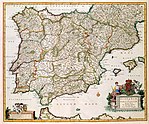Siege of Albarracín (1284)
| Siege of Albarracín | |||||||
|---|---|---|---|---|---|---|---|
| Part of the War of the Castilian Succession (1284-90) | |||||||
 View of the city of Albarracín. | |||||||
| |||||||
| Belligerents | |||||||
| Commanders and leaders | |||||||
| Strength | |||||||
200 Knights | |||||||
Part of a series on the |
|---|
| History of Spain |
 |
Early history
|
Medieval
|
Early modern
|
Modern
|
Contemporary
|
By topic
|
Timeline |
The Siege of Albarracín was a battle fought during the reign of Peter III of Aragon, King of Aragón from the months of April to September 1284. Albarracín, which had for some time belonged to Juan Núñez I de Lara, the head of the House of Lara, was besieged by an Aragonese force. The siege resulted in the successful taking of the city by Aragonese forces after which, Peter III handed gifted the city to his illegitimate son, Ferdinand of Aragón.
Contents
1 Context
2 The battle
3 Consequences
4 See also
5 References
5.1 Bibliography
Context
Albarracín was a Señorío of Muslim origin that formed part of the Muslim Kingdom of Valencia. The Señorío was formed when a Navarese noble from the House of Azagra militarily helped the Valencian kingdom. The Señorío de Albarracín was granted to this noble who repopulated the city with people from Navarre. After the conquest of Valencia by James I of Aragon, the territory was left in a legal vacuum. The local nobility, taking advantage of the questionable legal status, declared their independence (de facto) from both Valencia and Aragon.
After the death of the infante Ferdinand de la Cerda, the eldest son of Alfonso X of Castile, the forces of the infante Sancho and those of Alfonso de la Cerda, the
began a period of war for succession to the throne of the Kingdom of Castile. The contemporary lord or Señor de Albarracín was Juan I Núñez de Lara. In 1284, he was supporting the claim of the Infantes de la Cerda (although his allegiance would shift various times) and along with them, he had forged an alliance with the Kingdom of Navarre and the Kingdom of France, the alliance stipulated in the Treaty of Ágreda of 1281.
In an effort to strike at Juan I Núñez de Lara, Sancho IV made a deal with the Kingdom of Aragon which ceded sovereignty over the Señorío de Albarracín, which had up until then been a part of the Kingdom of Castile, to Peter III of Aragon upon its capture by either Castilian or Aragonese forces.[1] Prior to his support of the de la Cerda claims to the throne, Juan I Núñez of Lara was a subject of the Castilian crown.
Shortly after the Desafío de Burdeos, Juan Núñez I ambushed Peter III of Aragon with the goal of taking him prisoner back to France to be presented to Philip III of France. In June 1283, Peter III was in the area of Tarazona conducting attack on Navarre and Aragón in which he conquered and sacked various towns, the Castillo de Ull amongst them.
The battle
In winter of 1283, whilst Juan Núñez I de Lara was in Treviño raising Navarese reinforcements to defend his city from the Aragonese who had by then declared war against him, he was besieged by Peter III of Aragon at Albarracín with only around 200 knights.[2]
From April until September 1284, the besieging forces built their camp in the streets of the town of Albarracín (literally on Calle de los Palacios) for their soldiers to remain under cover and in comfort with stores and housing for the winter. On 29 September 1284, after many months of siege, the city surrendered and was occupied by troops of the Crown of Aragon. The Aragonese king, upon capturing the city, gave it as a gift to his illegitimate child with Inés Zapata, Ferdinand of Aragon.[3]
Consequences
Although Juan Núñez II de Lara, son of the defeated Juan Núñez I attempted various times to retake his ancestral property of Albarracín back from the Aragonese, the city eventually passed to the Aragonese Crown.[2]
See also
- Juan I Núñez de Lara
- Peter III of Aragon
- Sancho IV of Castile
References
^ Carlos Ayala Martínez, Paces castellano-aragonesas de Campillo-Ágreda (1281)
^ ab José Luis Castán Esteban, Historia del Señorío de Albarracín[permanent dead link]
^ de Salazar, Luis (1697). "VIII". In Mateo de Llanos y Guzmán. Historia genealógica de la Casa de Lara. volume 3. Madrid. pp. 134–135..mw-parser-output cite.citationfont-style:inherit.mw-parser-output qquotes:"""""""'""'".mw-parser-output code.cs1-codecolor:inherit;background:inherit;border:inherit;padding:inherit.mw-parser-output .cs1-lock-free abackground:url("//upload.wikimedia.org/wikipedia/commons/thumb/6/65/Lock-green.svg/9px-Lock-green.svg.png")no-repeat;background-position:right .1em center.mw-parser-output .cs1-lock-limited a,.mw-parser-output .cs1-lock-registration abackground:url("//upload.wikimedia.org/wikipedia/commons/thumb/d/d6/Lock-gray-alt-2.svg/9px-Lock-gray-alt-2.svg.png")no-repeat;background-position:right .1em center.mw-parser-output .cs1-lock-subscription abackground:url("//upload.wikimedia.org/wikipedia/commons/thumb/a/aa/Lock-red-alt-2.svg/9px-Lock-red-alt-2.svg.png")no-repeat;background-position:right .1em center.mw-parser-output .cs1-subscription,.mw-parser-output .cs1-registrationcolor:#555.mw-parser-output .cs1-subscription span,.mw-parser-output .cs1-registration spanborder-bottom:1px dotted;cursor:help.mw-parser-output .cs1-hidden-errordisplay:none;font-size:100%.mw-parser-output .cs1-visible-errorfont-size:100%.mw-parser-output .cs1-subscription,.mw-parser-output .cs1-registration,.mw-parser-output .cs1-formatfont-size:95%.mw-parser-output .cs1-kern-left,.mw-parser-output .cs1-kern-wl-leftpadding-left:0.2em.mw-parser-output .cs1-kern-right,.mw-parser-output .cs1-kern-wl-rightpadding-right:0.2em
Bibliography
González Jiménez, Manuel (October 2004). Alfonso X el Sabio (1st ed.). Barcelona: Editorial Ariel S. A. ISBN 84-344-6758-5.
Ibáñez de Segovia Peralta y Mendoza, Gaspar; Marqués de Mondejar (1777). Joachin Ibarra, ed. Memorias historicas del Rei D. Alonso el Sabio i observaciones a su chronica. Madrid.
De Loaysa, Jofré; García Martínez, Antonio (1982). Academia Alfonso X el Sabio, Colección Biblioteca Murciana de bolsillo Nº 27, ed. Crónicas de los Reyes de Castilla Fernando III, Alfonso X, Sancho IV y Fernando IV (1248-1305) (in Latin and Spanish) (2ª ed.). Murcia. ISBN 84-00-05017-7.
de Salazar y Castro, Luis (1697). Mateo de Llanos y Guzman, ed. Historia genealógica de la Casa de Lara. volume 3. Madrid.
Valdeón Baruque, Julio (1986). Junta de Castilla y León, Consejería de Educación y Cultura, ed. Alfonso X el Sabio (1ª ed.). Castilla y León. ISBN 84-505-3366-X.
Zurita, Jerónimo (2005). Institución Fernando el Católico, ed. Anales de Aragón (1ª ed.). ISBN 84-7820-823-2.
Coordinates: 40°24′00″N 1°27′00″W / 40.4000°N 1.4500°W / 40.4000; -1.4500